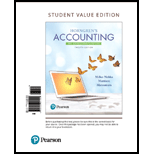
Horngren's Accounting: The Managerial Chapters, Student Value Edition (12th Edition)
12th Edition
ISBN: 9780134491509
Author: MILLER-NOBLES, Tracie L., Mattison, Brenda L., Matsumura, Ella Mae
Publisher: PEARSON
expand_more
expand_more
format_list_bulleted
Concept explainers
Textbook Question
Chapter 6, Problem S6.7SE
Comparing Cost of Goods Sold under FIFO, LIFO, and Weighted-average
Learning Objective 3
Refer to Short Exercises S6-4  through S6-6.
through S6-6.  After completing those exercises, answer the following questions:
After completing those exercises, answer the following questions:
Requirements
1. Which inventory costing method produced the lowest cost of goods sold?
2. Which inventory costing method produced the highest cost of goods sold?
3. If costs had been declining instead of rising, which inventory costing method would have produced the highest cost of goods sold?
Expert Solution & Answer
Want to see the full answer?
Check out a sample textbook solution
Students have asked these similar questions
provide correct answer plz help me
Provide answer
Accounting
Chapter 6 Solutions
Horngren's Accounting: The Managerial Chapters, Student Value Edition (12th Edition)
Ch. 6 - Which principle or concept states that business...Ch. 6 - Which inventory costing method assigns to ending...Ch. 6 - Assume Nile.com began April with 14 units of...Ch. 6 - Suppose Nile.com used the weighted-average...Ch. 6 - Which inventory costing method results in the...Ch. 6 - Which of the following is most closely linked to...Ch. 6 - At December 31, 2018, Stevenson Company overstated...Ch. 6 - Suppose Maestro’s had cost of goods sold during...Ch. 6 - Suppose used the LIFO inventory costing method and...Ch. 6 - Prob. 1RQ
Ch. 6 - Prob. 2RQCh. 6 - Prob. 3RQCh. 6 - Prob. 4RQCh. 6 - Discuss some measures that should be taken to...Ch. 6 - Under a perpetual inventory system, what are the...Ch. 6 - When using a perpetual inventory system and the...Ch. 6 - During periods of rising costs, which inventory...Ch. 6 - What does the lower-of-cost-or market (LCM) rule...Ch. 6 - What account is debited when recording the...Ch. 6 - What is the effect on cost of goods sold, gross...Ch. 6 - When does an inventory error cancel out, and why?Ch. 6 - How is inventory turnover calculated, and what it...Ch. 6 - How is days’ sales inventory calculated, and what...Ch. 6 - When using the periodic inventory system, which...Ch. 6 - When using periodic inventory system and...Ch. 6 - Determining inventory accounting principles...Ch. 6 - Determining inventory costing methods Learning...Ch. 6 - Preparing a perpetual Inventory record and journal...Ch. 6 - Preparing a perpetual inventor, record and journal...Ch. 6 - Preparing a perpetual inventor record and journal...Ch. 6 - Preparing a perpetual inventory record and journal...Ch. 6 - Comparing Cost of Goods Sold under FIFO, LIFO, and...Ch. 6 - Applying the lower-of-cost-or-market rule Learning...Ch. 6 - Determining the effect of an inventory error...Ch. 6 - Computing the rate of inventory turnover and days’...Ch. 6 - Computing periodic inventory amounts—FIFO Learning...Ch. 6 - Computing periodic inventory amounts—LIFO Learning...Ch. 6 - Computing periodic inventory...Ch. 6 - Using accounting vocabulary Learning Objective 1,...Ch. 6 - Comparing inventory methods Learning Objective 2...Ch. 6 - Measuring and journalizing merchandise inventory...Ch. 6 - Measuring and journalizing merchandise inventory...Ch. 6 - Measuring ending inventory and cost of goods sold...Ch. 6 - Comparing amounts for cost of goods sold, ending...Ch. 6 - Comparing cost of goods sold and gross...Ch. 6 - Applying the lower-of-cost-or-market rule to...Ch. 6 - Applying the lower-of-cost-or-market rule to...Ch. 6 - Measuring the effect of an inventory error...Ch. 6 - Correcting an inventory error-two years Learning...Ch. 6 - Computing inventory turnover and days’ sales in...Ch. 6 - Comparing ending merchandise inventory, cost of...Ch. 6 - Computing periodic inventory amounts Learning...Ch. 6 - Accounting for inventory using the perpetual...Ch. 6 - Accounting for inventory using the perpetual...Ch. 6 - Accounting principles for inventory and applying...Ch. 6 - Prob. P6.31APGACh. 6 - Prob. P6A.32APGACh. 6 - Prob. P6.33BPGBCh. 6 - Prob. P6.34BPGBCh. 6 - Accounting principles for inventory and applying...Ch. 6 - Prob. P6.36BPGBCh. 6 - Prob. P6A.37BPGBCh. 6 - Prob. P6.38CTCh. 6 - Prob. P6.39CPCh. 6 - Prob. P6.40PSCh. 6 - Prob. 1CPCh. 6 - Prob. 2CPCh. 6 - Prob. 3CPCh. 6 - Prob. 4CPCh. 6 - Prob. 5CPCh. 6 - Prob. 6CPCh. 6 - Prob. 7CPCh. 6 - Prob. 8CPCh. 6 - Prob. 9CPCh. 6 - Prob. 10CPCh. 6 - Prob. 11CPCh. 6 - Prob. 6.1TIATCCh. 6 - Prob. 6.1DCCh. 6 - Prob. 6.1FSC
Knowledge Booster
Learn more about
Need a deep-dive on the concept behind this application? Look no further. Learn more about this topic, accounting and related others by exploring similar questions and additional content below.Similar questions
- Cordova Accounting Services had $150,000 in gross receipts for the year. It cost the company $42,000 to lease and operate its offices for the year. The company's landlord gave the company a $150 monthly discount in return for accounting services. One client gave the company a printer with a retail price of $3,500 and a fair market value of $2,800 in exchange for accounting services. Based on these facts, what is the company's gross income for the year?arrow_forwardneed correct answer of this question of general accountingarrow_forwardNeed helparrow_forward
arrow_back_ios
SEE MORE QUESTIONS
arrow_forward_ios
Recommended textbooks for you
 Cornerstones of Financial AccountingAccountingISBN:9781337690881Author:Jay Rich, Jeff JonesPublisher:Cengage LearningCentury 21 Accounting Multicolumn JournalAccountingISBN:9781337679503Author:GilbertsonPublisher:Cengage
Cornerstones of Financial AccountingAccountingISBN:9781337690881Author:Jay Rich, Jeff JonesPublisher:Cengage LearningCentury 21 Accounting Multicolumn JournalAccountingISBN:9781337679503Author:GilbertsonPublisher:Cengage Financial Accounting: The Impact on Decision Make...AccountingISBN:9781305654174Author:Gary A. Porter, Curtis L. NortonPublisher:Cengage Learning
Financial Accounting: The Impact on Decision Make...AccountingISBN:9781305654174Author:Gary A. Porter, Curtis L. NortonPublisher:Cengage Learning

Cornerstones of Financial Accounting
Accounting
ISBN:9781337690881
Author:Jay Rich, Jeff Jones
Publisher:Cengage Learning

Century 21 Accounting Multicolumn Journal
Accounting
ISBN:9781337679503
Author:Gilbertson
Publisher:Cengage


Financial Accounting: The Impact on Decision Make...
Accounting
ISBN:9781305654174
Author:Gary A. Porter, Curtis L. Norton
Publisher:Cengage Learning
Chapter 6 Merchandise Inventory; Author: Vicki Stewart;https://www.youtube.com/watch?v=DnrcQLD2yKU;License: Standard YouTube License, CC-BY
Accounting for Merchandising Operations Recording Purchases of Merchandise; Author: Socrat Ghadban;https://www.youtube.com/watch?v=iQp5UoYpG20;License: Standard Youtube License